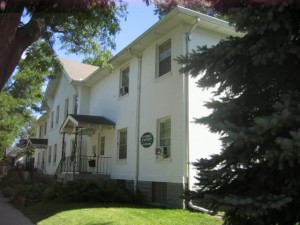
After two cold and rainy summers that resulted in slow ticket sales, Wonderland closed in 1911. The only evidence on the landscape that Wonderland ever existed is the Infantorium, which is this apartment building on the southeast corner of 31st Avenue and 31st Street.
By Sue Hunter Weir
The story of the Wonderland babies is as much of a crowd pleaser today as it was when Wonderland Park was in operation between 1905 and 1912. When Wonderland opened its gates in 1905, it was not just a big news story””it was a huge story. It wasn”'t just that having a modern amusement park was important to the city”'s image and sense of itself as the gateway to the Northwest, it was the effect that the park had on the city”'s infrastructure and economy. In 1905, for the first time, it became possible for Minneapolitans to take a streetcar from Hennepin and Lake to 31st Avenue and Lake without going through downtown. It was no coincidence that 31st and Lake marked the entrance to Wonderland Park. The following year, a newly constructed addition, the Selby-Lake streetcar line, provided easier access to the park for visitors from St. Paul. On busy days, streetcars ran as often as every thirty seconds to handle the crowds. In its first year of operation, over half-a-million people came to see the park.
The thing that made it all possible””the streetcars, the rides, and the 120-foot beacon of light that could be seen for miles””was electricity. What few people realized at the time was the electricity was also capable of saving lives.
At the far end of the park, stood the Infantorium, essentially a neo-natal intensive care hospital for premature babies. For the price of a ten-cent ticket, visitors could see the hospital”'s shiny, new incubators. Incubators, at least those used for raising poultry were not unknown, but the idea of using an incubator to raise a human baby came as something of a surprise to many of the fair”'s visitors. Many people were confused about how the baby incubators worked, and, drawing on their experience of watching eggs turn into chicks in “hatcheries,” thought that the babies were conceived and born in the incubators. The steel-framed boxes with their glass sides became known as “automatic mothers,” although some of the more poetically-inclined reporters described them as “glass castles.”
Wonderland was modest compared to the world”'s fairs and expositions that preceded and followed it. Although the Tribune called the park “immense,” it was only ten acres; in contrast, the St. Louis World”'s Fair held one year earlier covered 1,275 acres. And Minnesotans”' tastes were more restrained””there were no freak shows or exotic dancers, no wild animals or beer gardens, and no dancing on Sundays. But, the park wasn”'t (with the exception of the Infantorium) intended to be educational or uplifting. It was all about having fun.
Surrounded by all that fun were the babies, or, as the Minneapolis Tribune described them, “tiny morsels of humanity,” wrapped in fleece-lined robes made especially for them by French nuns. The robes were tied with pink or blue ribbons, to distinguish girls from boys, and each baby had an identification necklace (another novel idea) to prevent the staff from returning a baby to the wrong family.
Dr. Martin Couney, who is credited with inventing the incubator and who was the first to demonstrate its use at world”'s fairs and amusement parks, came to Minneapolis in 1905 to oversee the opening of the Infantorium (or “Infant Institute,” as he preferred to call it). Although most of his life”'s work was done at Coney Island in New York, Dr. Couney was a tireless advocate for premature infants. His goal was the same year after year: no baby who received the treatment that he prescribed, whether at Coney Island or elsewhere, would die. Given how fragile and ill his tiny patients were, it was a goal that was impossible to meet. Nonetheless, he and his followers had astonishing success.
The exact number of babies who were treated at Wonderland is not known, and the number of those who did not survive is difficult, if not impossible, to reconstruct. Eleven of those who did not are buried in Minneapolis Pioneers and Soldiers Cemetery, but, thanks to Dr. Couney and Wonderland, many of those who would most likely would have died, survived.









